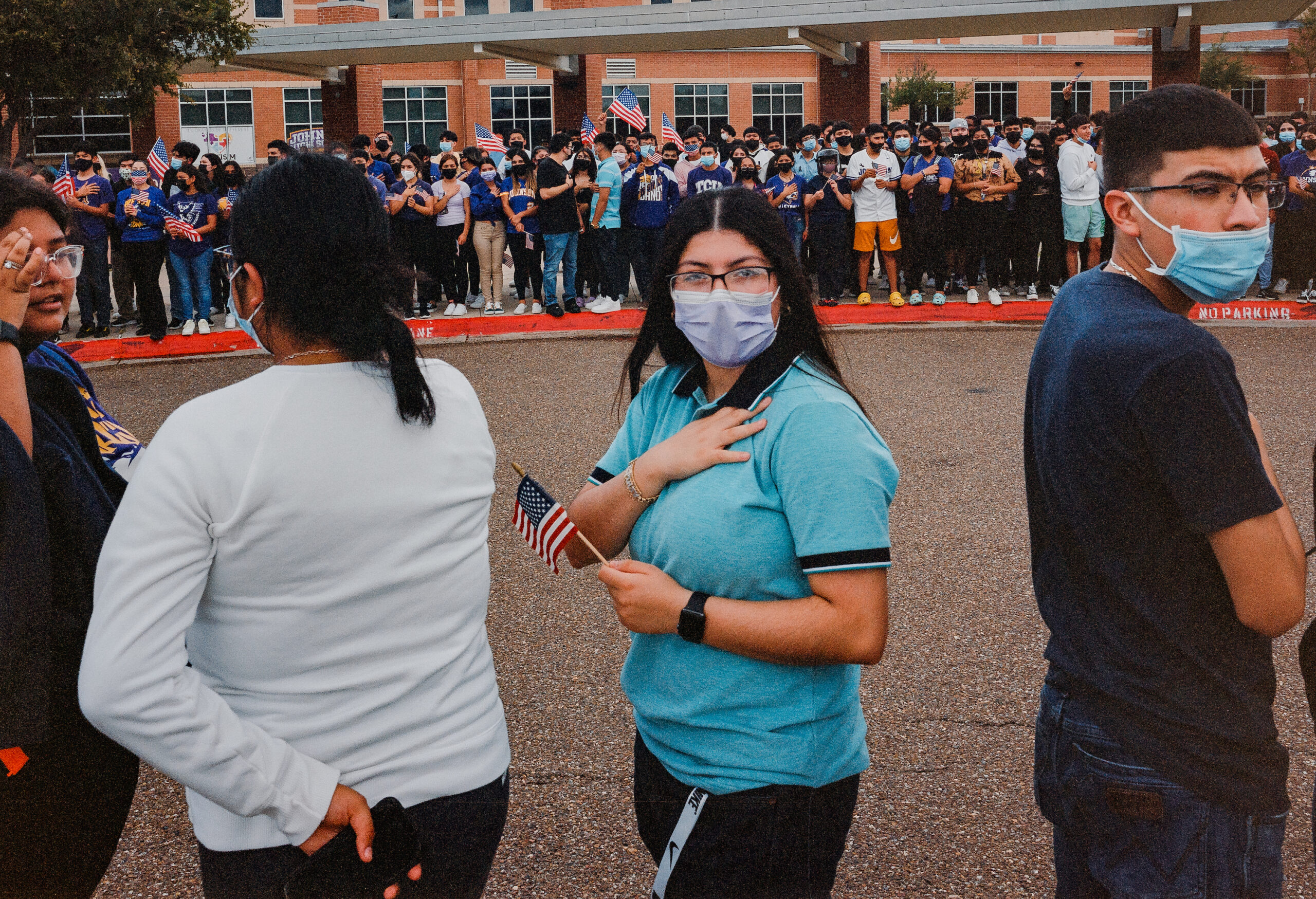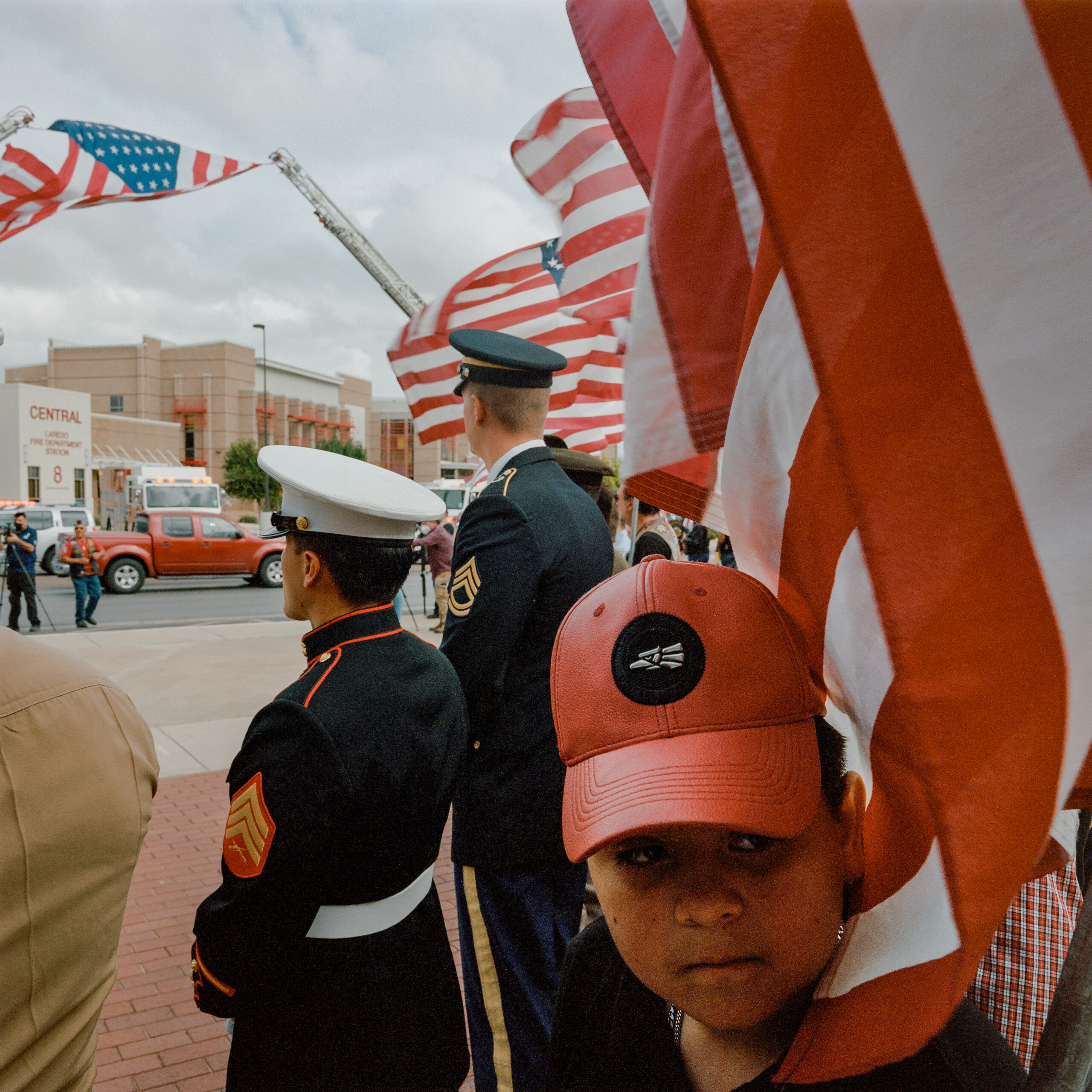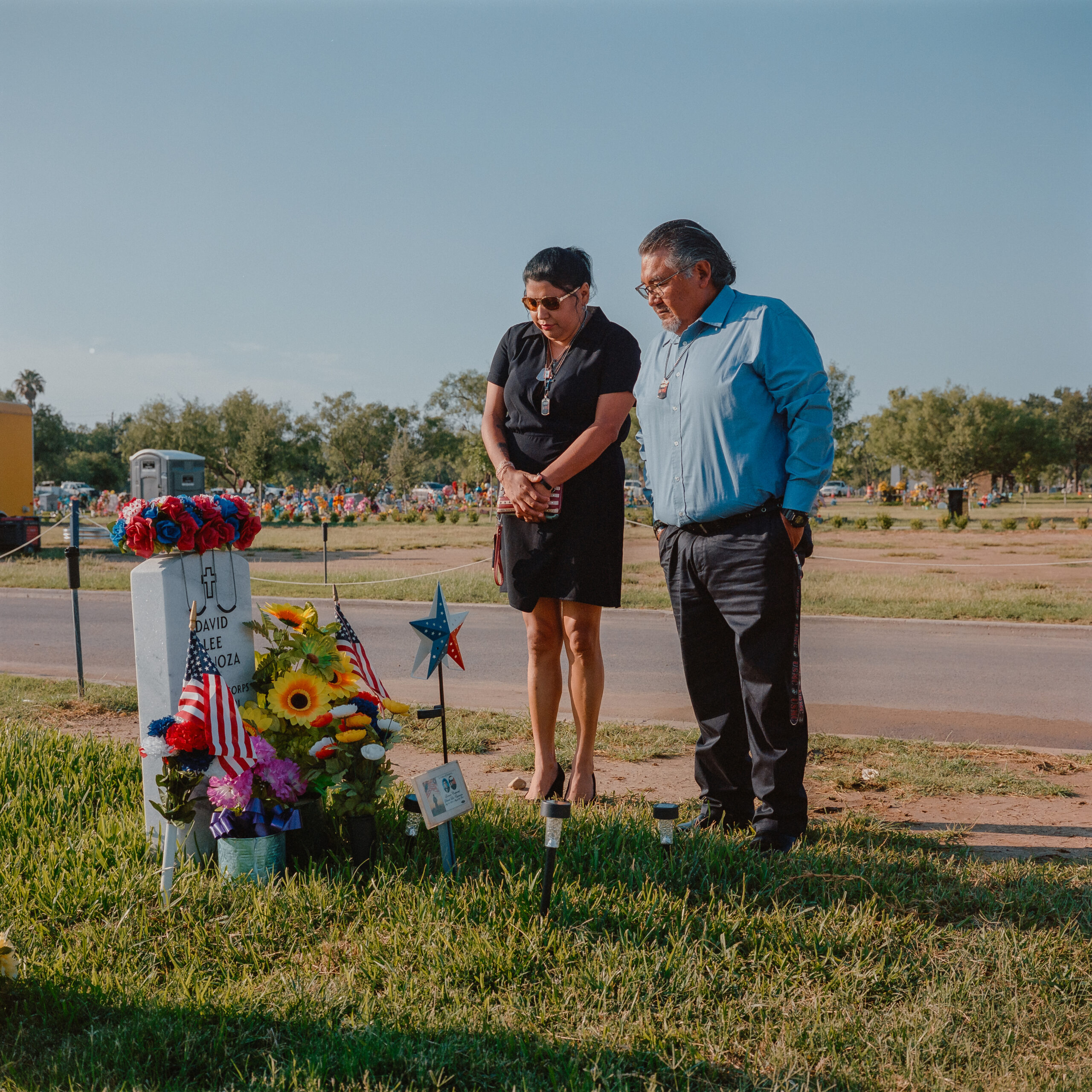This piece was produced in collaboration with Latino USA. Please visit their site for the audio version of this story.
The house on Sabana Lane in Laredo is a repository of memories. Military posters, American flags, crosses, and photographs hang on the wall, each of them a piece of David Lee Espinoza’s story that ended in Afghanistan.
“This was his cross he was wearing when he passed, and I wear it,” said his mother, Elizabeth Holguin, grabbing the necklace in her hands. “I always feel like he’s around me.”
Espinoza, a lance corporal in the U.S. Marines, died in the waning days of the U.S. evacuation of Afghanistan when suicide bombers blew themselves up near the Kabul airport on August 26, 2021. Twelve other service members, about half of them Latino, and more than 150 Afghans perished in the attack.
Born just months before the war began, Espinoza was one of the last to die when America’s longest war came to an end. He was 20.
Espinoza is one of an estimated 7,000 American service members who lost their lives in the post-9/11 wars that include Afghanistan and Iraq, according to Brown University’s Cost of War Project. Another 30,000 of these service members and veterans later died by suicide.
For decades, the U.S. military has targeted communities of color for recruitment. Latinos, according to the U.S. Department of Defense, make up about 18 percent of the active duty force. The numbers are even higher in the Marine Corps, in which Hispanics make up 24 percent of active duty members. Latinos are already the largest demographic group in Texas, and will account for most of the country’s population growth—60 percent—through 2050. A 2022 report from the Department of Defense showed Latinos were the fastest-growing segment of the military.
“Our nation’s ability to fill ranks in the future will depend on our ability to successfully recruit Latinos,” Louis Caldera, then secretary of the army, told the Los Angeles Times in 1999.
Irene Garza is a historian of U.S. militarism and Latinidad and an affiliate of the Center for the Study of Race, Indigeneity, Transnationalism and Migration at Yale University. She said recruiters began aggressively marketing and targeting people, including Latinos, for enlistment after the draft ended in 1973 under President Richard M. Nixon, marking the switch to an all-volunteer force.
“The U.S. war in Vietnam demonstrated to military personnel the demographic diversity of the Latinx population,” she said. “Latinos constituted a previously ignored, historically marginalized community.”
The military markets aggressively to Latinos with Spanish-language ads and hefty recruitment efforts in high schools with large Latino populations, using monetary incentives and opportunities for continuing education to entice Latinos to serve. For immigrants, the military can offer a path to citizenship, but even for those who are born here, military service offers a way to establish one’s bona fides as an American.
“It is through laboring in the uniform that you prove your citizenship,” Garza said.
Espinoza’s life and death tell a larger story about why some Latinos decide to join the U.S. Armed Forces, the strategies and incentives the military uses to recruit them, and how families and communities remember those who sacrifice their lives.



In late May, the hallways of Lyndon B. Johnson High School in Laredo were filled with students carrying backpacks. They walked past the library with gold lettering overhead that reads, “Lance Corporal David Lee Espinoza Memorial Library,” renamed in 2022 in his honor.
A recruitment poster to the side with a photo of a man in uniform reads, “Take one. It’s the last thing you’ll be given in the Marine Corps.” Underneath, a pouch meant to hold pamphlets sits empty.
Michael Carrillo has been teaching at LBJ for about 20 years. The high school is about 99 percent Hispanic, and about 90 percent of the students are poor. He said high school is when a lot of kids are figuring out what they want to do as they enter adulthood, and he often hears students talk about joining the armed forces.
Carrillo tells students interested in a military career about the school’s Junior Reserve Officers’ Training Corps (JROTC) program.
“If I ever hear a student telling me that they may be interested in the military, I would highly encourage them to join the JROTC,” Carrillo said. “It teaches the kids discipline … it’s a very structured environment.”
JROTC, an elective class funded in part by the military, is offered in many public high schools across the country. In these classes, students wear military uniforms, do physical training, and learn about leadership and civics. JROTC programs don’t technically recruit students but, coupled with military recruiters visiting campuses, often act as a funnel for students deciding to join the armed forces.
Last year, a New York Times investigation found thousands of students of color and from low-income areas were being pushed into JROTC programs. Some schools even made the program mandatory.
In recent years, as the military has faced enlistment shortfalls—this year, the Army, Navy, and Air Force are expected to miss their goals by thousands—recruiters have drawn in immigrants with a fast track to citizenship.
In 2023, the Air Force announced that 14 trainees were the first to complete basic military training and become U.S. citizens as part of a new program that streamlines the naturalization process. It’s part of a collaboration with U.S. Citizenship and Immigration Services that grants trainees citizenship before they graduate. Last year, the Army reestablished a program that would allow legal permanent residents to apply for accelerated naturalization as part of basic training.
Each year, thousands of service members and their families become naturalized U.S. citizens, according to a website run by the Department of Defense.
The military also offers economic benefits that might appeal to students at places like Laredo’s LBJ High School.
Even high-achieving students with higher education ambitions in some communities simply can’t afford college, so they turn to the military, which advertises that it can help pay up to full college tuition for public and in-state schools and provide money for housing and books. They also advertise that if college isn’t in a student’s future, they can also help pay for trade schools, technical schools, and certification programs.
“They want to be able to provide for their families,” Carrillo said. “There’s a lot of need in our area, and a lot of them take on very mature roles at such a young age where they’re taking care of all of their younger brothers and sisters. It gives them that opportunity where they see that college can be paid for.”
In addition to the military helping pay for higher education, last year the Army also increased bonuses it pays to future soldiers who ship to basic training within 45 days of signing a four-year contract.
It’s these types of incentives that critics like David Morales have said are misleading. They oversell the benefits of military service while minimizing the drawbacks and risks.
Morales grew up in San Diego—a city with a naval base where recruiters and military propaganda are commonplace. As a student, he didn’t question the militarism he saw around him, but later it inspired him to get involved with Project YANO, an organization that was founded in 1984 to provide young people with an alternative point of view about military enlistment.
“Recruiters prey on young people who maybe come from the background that I did and who have limited opportunities, and [recruiters] take advantage of their economic situation and promise them huge signing bonuses or say things like, ‘We’re going to help you or your parents become citizens quicker,’” he said.
Morales said he was outraged to discover that military recruitment, including JROTC programs, was most common in schools with a large population of poor students.
“In other schools that were in more affluent areas … they didn’t have any military recruiters or military courses like the Junior Reserve Officer Training Corps,” Morales said.
“Recruiters prey on young people who maybe come from the background that I did and who have limited opportunities.”
Almost 15 years later, Morales and Project YANO continue their work and get invited by teachers to schools and college fairs to give presentations. Morales said he and his organization also discuss how intentional the military is in its recruitment efforts.
“The military knows what they’re doing when they … release ads of Latino-looking people wearing super tidy uniforms and when they send Latino recruiters to the same communities that they came from and in tidy uniforms and nice cars,” he said.
The YANO speakers also address the prevalence of discrimination, harassment, and sexism in the military—something that Ana Yeli Ruiz, a former Marine and member of Project YANO, said she experienced.
“It’s pretty common to be verbally or sexually harassed, kind of like it was almost the norm,” said Ruiz, who has shared her story with students and on YouTube.
Ruiz said it happened within the first year of her arrival in San Diego for her duty station.
“They pretty much told me that it was my fault and kind of just gaslit me,” she said. “That culture of toxic sexual culture and harassment was just normalized and nobody batted an eye.”
Department of Defense data showed a 13 percent increase in sexual assaults in the military from fiscal year 2020 to 2021.
“I guess I really bought into the camaraderie and the [idea that] being family and being a brother and sisterhood, that we would have each other’s backs,” Ruiz added.
Morales said Project YANO helps people find other ways to pay for college and assists them in finding jobs outside of the military. They’re trying to show students they have more options than they think.
“It is hard to tell someone who seemingly has no other option, who’s in a very difficult financial situation, ‘Hey, don’t do this,’ and that’s why we don’t tell people what to do,” he said. “We think it’s important for people to make their own informed decision, but we believe that they should know what they’re getting themselves into.”
Morales believes the military is now aggressively trying to recruit more people into its ranks because of its low recruitment numbers.
“A year ago, the Army dropped its high school graduation requirement, and that was outrageous,” he said. “That was a desperate move by the military to fill its recruitment quotas.”
“It’s completely predatory to target students who are in debt and to go risk their lives to help pay back some of this debt.”
Shortly after, the Army reversed its policy.
Last year, 19 Republican lawmakers sent President Joe Biden a letter condemning the administration’s proposal to eliminate some student loan debt because it would take away an incentive for young people to join the military.
“By forgiving such a wide swath of loans for borrowers, you are removing any leverage the Department of Defense maintained as one of the fastest and easiest ways to pay for higher education,” the letter said. “We recognize the loan forgiveness programs have issues of their own, but this remains a top recruiting incentive.”
“It’s completely predatory to target students who are in debt and to go risk their lives to help pay back some of this debt,” Morales said.
Jessica Lavariega Monforti is the coauthor of Proving Patriotismo: Latino Military Recruitment, Service, and Belonging in the US. She found that, as Morales had noticed, JROTC programs tend to be concentrated in economically poorer areas like the Rio Grande Valley in what some call the “poverty draft.”
“If you think about the Rio Grande Valley as a metropolitan statistical area, it is one of the poorest metropolitan areas in the United States,” she said. “What we saw was that recruitment was strongest in the schools that had higher rates of poverty.”
She said her research also challenges the prevailing narrative about whom the military is trying to recruit. “The story that we have been told is that the military is the last option for people who didn’t have other opportunities,” Lavariega Monforti said. “[But] the recruiters aren’t going after at-risk students; they are going after students who are seen as role models, who are doing well in school, who do have other options.”
Lavariega Monforti explained that military service offers Latinos—many of whom are immigrants or the children of immigrants—a sense of civic identity and belonging.
“All of a sudden, you have a recruiter who said, ‘Come represent the United States; come be a part of our community; come be a part of this effort to protect … our families and communities abroad,” she said. “That is hugely appealing to young people who have felt pushed away and alienated.”
Lavariega Monforti points out that the military uses a lot of Spanish-language ads like the “Yo Soy El Army” campaign that ran from 2001 to 2005.
David Espinoza, like so many others, grew up around all of these influences. At LBJ High School, he decided at one point that college wasn’t for him, so a military career was an option. But his parents said that the driving force for him to join the Marines came from a sense of duty to serve his country.
Espinoza graduated in 2019 and went to California for 13 weeks of basic training. Recruits undergo things like physical and combat conditioning and martial arts training.
Things were going well until Espinoza hurt himself on a long hike, after which he was transported to a special unit for recruits in need of medical attention. That’s where he met Angel Sanchez, who had tested positive for tuberculosis.
Sanchez remembered Espinoza being a jokester. They teased each other about being in the medical unit. “Every day I’d be like, ‘Shut up, Espinoza, that’s why your ankle doesn’t work,’ and he’d go, ‘Shut up, Sanchez, that’s why your lungs don’t work,’” Sanchez recalled. “I never heard him talk bad about anybody, and he was never sad.”
Both Espinoza and Sanchez healed, and after boot camp graduation, they went their separate ways.

Before Afghanistan, the military sent Espinoza to Jordan. His mom remembers Espinoza saying things were slow.
“When he called me, he just said, ‘Mom, I’m bored here. It’s very calm. I need some action,” Holguin recalled. “I was like, ‘What are you talking about? I was like, ‘Oh, no, no, no, don’t say that.’”
Espinoza made another call home on August 13, 2021. His parents were sitting on rocking chairs in their backyard when they heard Espinoza say he was going to Afghanistan.
“I told him, ‘Okay, you know it’s only a few days because this is almost over,’” recalled Victor Dominguez, his father. “On the inside, it was killing me.”
There was a lot of news coverage about what was happening in Afghanistan then. Videos showed people hopping onto the wings of airplanes trying to escape. The situation was escalating.
Holguin couldn’t keep herself from crying, her husband, Dominguez recalled.
“She was crying because she knew where he was going,” he said. “I just kept talking to him the whole time, just trying to be positive with him.”
A few days later, Espinoza arrived in Afghanistan. Holguin said she was able to talk to Espinoza a few times while he was there. She remembers their last call.
“When I heard him, I kind of think he knew because of the way he was talking to me,” she said. “He was saying, ‘If anything, you know, I love you … it’s going to be okay.’”
Two days later, on August 26, 2021, news broke about an explosion in Afghanistan. Dominguez rushed to turn on the television. Holguin was on a break at work when she came across a post on Facebook detailing what was happening and hurried home. Dominguez stayed up until 1 a.m. waiting for more news. Holguin went to bed but couldn’t sleep.
At 2 a.m., the phone rang. Officers were already outside their home.
“I knew right away, it was him,” Holguin said through tears.
The next morning, she posted on Facebook that Espinoza had been killed.
Espinoza’s funeral procession took his body through town, including a stop at his high school.
“Every street we went through, you know, just seeing how much respect he got for what he went through, what happened to him,” Dominguez said. “I don’t think there are words to describe it.”
In addition to having the school library at LBJ named in his honor, officials in Laredo dedicated a street to him. A local, veteran-owned business displays a mural of him in his uniform. Every Memorial Day, local veterans and families celebrate Espinoza.

Holguin and Dominguez want to keep their son’s story alive. One way they’re trying to do so is by pushing for changes to how money from the GI Bill is used.
The GI Bill was originally set up in the 1940s to help returning veterans reintegrate into society. It provided help with things like a mortgage, job training, or money to go to school. At the time, the majority of the help went to White veterans.
Currently, if a service member dies in action, some benefits go to their spouse or child, but Espinoza had neither. His parents would like to see funds for education go to his siblings.
“Why not give his brothers the opportunity?” Holguin said.
David’s parents plan to continue to speak out and help keep their son’s legacy alive.

This piece was produced in collaboration with Latino USA. Please visit their site for the audio version of this story.







